OSAMA BIN LADEN AS A JIHADIST IN AFGHANISTAN

Osama bin Laden in
Afghanistan in the 1980s Paul Haven of Associated Press wrote: Bin Laden's path to militant Islam began as a teenager in the 1970s when he got caught up in the fundamentalist movement then sweeping Saudi Arabia. He was a voracious reader of Islamic literature and listened to weekly sermons in the holy city of Mecca. [Source: Paul Haven, AP, May 2, 2011]
Abdel-Bari Atwan, editor of Al-Quds al-Arabi, London-based newspaper, spent 10 days with bin Laden in an Afghan cave in 1996. He said bin Laden "touched the root of the grievances of millions in the Arab world" when he presented himself as the alternative to Arab regimes that have been incapable of liberating Arab land from Israeli occupation and restoring pride to their people. He said bin Laden and his followers never feared death. "Those guys spoke about death the way young men talk about going to the disco," Atwan said. "They envied those who fell in battle because they died as martyrs in God's cause."
Kate Zernike and Michael T. Kaufman wrote in the New York Times: “His reedy voice seemed to belie the warrior image he cultivated, a man whose constant companion was a Kalashnikov rifle that he boasted he had taken from a Russian soldier he had killed. The world’s most threatening terrorist, he was also known to submit to dressings down by his mother. While he built his reputation on his combat experience against Soviet troops in Afghanistan in the 1980s, even some of his supporters questioned whether he had actually fought. [Source: Kate Zernike and Michael T. Kaufman, New York Times, May 2, 2011]
Osama bin Laden “built his own legend, modeling himself after the Prophet Muhammad, who in the seventh century led the Muslim people to rout the infidels, or nonbelievers, from North Africa and the Middle East. Just as Muhammad saw the Koran revealed to him amid intense persecution, Bin Laden regarded his expulsions from Saudi Arabia and then Sudan in the 1990s as signs that he was a chosen one....Though he claimed to follow the purest form of Islam, many scholars insisted that he was glossing over the faith’s edicts against killing innocents and civilians. Islam draws boundaries on where and why holy war can be waged; Bin Laden declared the entire world as fair territory. In his vision, he would be the “emir,” or prince, in a restoration of the khalifa, a political empire extending from Afghanistan across the globe. “These countries belong to Islam,” he told the same interviewer, “not the rulers.”
Osama bin Laden’s Jihadist Influences
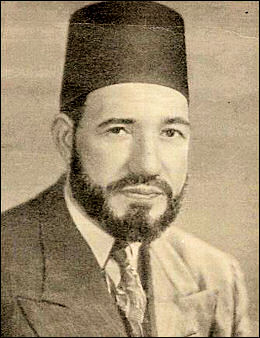
Hassan al-Banna, founder of
the the Muslim Brotherhood Osama bin Laden’s early Islamist views were shaped by a high school gym teacher who involved him in an after-school Islamic study group in high school and Abdullah Azzam, a charismatic scholar who introduced the young Osama to “the concept of transnational jihad” at university. See Osama bin Laden’s Education.
Osama bin Laden’s experience at King Abdulaziz University in Jidda gave his Islamic views more of a militant tinge. Kate Zernike and Michael T. Kaufman wrote in New York Times: “He became involved with the Muslim Brotherhood, a group of Islamic radicals who believed that much of the Muslim world, including the leaders of Saudi Arabia, lived as infidels, in violation of the true meaning of the Koran. And he fell under the influence of two Islamic scholars: Muhammad Quttub and Abdullah Azzam, whose ideas would underpin Al Qaeda. The Middle East was becoming unsettled in 1979, when Bin Laden was at the university. In Iran, Shiite Muslims mounted an Islamic revolution that overthrew the shah and made the United States a target. Egypt and Israel signed a peace treaty. And as the year ended, Soviet troops occupied Afghanistan. [Source: Kate Zernike and Michael T. Kaufman, New York Times, May 2, 2011]
The Middle East and the Muslim world were very unsettled in 1979, when Bin Laden was at the university. In Iran, the Ayatollah Khomeini lead an Islamic revolution that overthrew the shah and cast the United States as “The Great Satan.” target. Egypt and Israel signed a peace treaty, which nagered the rest of the Arab world. As the year ended, Soviet troops occupied Afghanistan.
Milton Viorst wrote in the Washington Post: “The year 1979, when [Osama bin Laden] was 21, marked a turning point for Osama and for Saudi Arabia. It was the year of the Iranian revolution, which ignited widespread religious militancy. Islamic radicals struck at royal power in a wild attack on the Holy Mosque in Mecca, and, though suppressed in bloody battle, the assault left the state badly shaken. The Sauds solicited help from the United States to preserve their status, and authorized construction of a major American base on Saudi soil. Osama made clear his disapproval of the infidel presence, generating tensions within the bin Laden family, which stood to profit handsomely from the project.” When “the Soviets invaded Afghanistan the bin Ladens rallied to make major contributions to the Afghan resistance, preponderantly Islamic, and sent Osama to Pakistan to oversee the distribution of funds. His work, being anti-communist, pasted over the family rift and delayed his own break with the Sauds and their American allies. [Source: Milton Viorst, Washington Post March 30, 2008; The Bin Ladens: An Arabian Family in the American Century by Steve Coll (Penguin Press, 2008)]
Osama bin Laden and Death
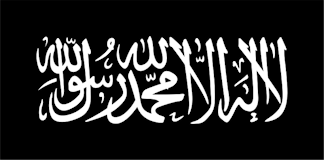
Flag of jihad In 2005, bin Laden’s former bodyguard, Abu Jandal, told the al-Quds al-Arabi newspaper, “Sheikh Osama gave me a pistol. The pistol had only two bullets, for me to kill Sheikh Osama with in case we were surrounded or he was about to fall into the enemy’s hands so that he would not be caught alive.” “As bin Laden himself put it to Jandal, if he were killed, “his blood would become a beacon that arouses the zeal and determination of his followers.” “The man who once enjoyed a quiet rural life in the mountains of Tora Bora aims in death to ascend into the pantheon of Islamic heroes — a Saladin for the 21st century “martyred” by those he calls “the Crusaders.” [Source: Peter Bergen, Washington Post, March 1, 2006]
Rahimullah Yusufzai, a leading Pakistani journalists who interviewed bin Laden twice in the late 1990s, told Bergen: “Bin Laden sees himself as a man who would sacrifice his life for his beliefs. He would like to go down fighting; he would like to become a martyr. He won’t surrender. I believe that he will be a much more popular man for many Muslims once he becomes a martyr, because Mr. bin Laden as a dead man would be even more potent than when he is alive. [Source: Peter Bergen, Vanity Fair, January 2006]
Abu Jandal told Bergen: In the case of his death, I think he will be a symbol for all those who follow him, especially in the case of his assassination. He will be an idol for all those who believe in his ideas. He will be a great inspiration for them to follow in his footsteps. His death will be a great force for stirring up everybody’s emotions and enthusiasm to follow him on the path of martyrdom.” Khalid Khawaja, who fought with bin Laden in Afghanistan, said: “He will never be captured. He’s not Saddam Hussein. He’s Osama. Osama loves death.”
Osama bin Laden Arrives in Pakistan-Afghanistan for the First Time in 1979
Pakistan-Afghanistan border area Osama bin Laden showed up in Pakistan in 1979 around the time of the Soviet invasion of Afghanistan. He met Afghan refugees and opposition leaders and returned to Saudi Arabia to raise funds for the Afghan resistance. In the early 1980s, he used his family business connections to help funnel equipment and weapons to the mujahidin.
Kate Zernike and Michael T. Kaufman wrote in the New York Times: “Bin Laden arrived in Pakistan-Afghanistan border within two weeks of the occupation. He said later that he had been asked to go by Saudi officials, who were eager to support the resistance movement. In his book “Taliban,” the Pakistani journalist Ahmed Rashid said that the Saudis had originally hoped that a member of the royal family might serve as an inspirational leader in Afghanistan, but that they settled on Bin Laden as the next closest thing when no princes volunteered. [Source: Kate Zernike and Michael T. Kaufman, New York Times, May 2, 2011]
Peter Bergen wrote in Vanity Fair: “The Soviet invasion of Afghanistan in 1979 was a profoundly shocking event for bin Laden, as it was for thousands of other devout young Muslims, who were drawn to the Afghan jihad during the 1980s. It was the first time since World War II that a non-Muslim power had invaded and occupied a Muslim nation. Indeed, for bin Laden it was the most transformative event of his life. [Source: Peter Bergen, Vanity Fair, January 2006]
Osama bin Laden later said "I was enraged, and went there at once." In 1997 he said: “The news was broadcast by radio stations that the Soviet Union invaded a Muslim country; this was a sufficient motivation for me to start to aid our brothers in Afghanistan. In spite of the Soviet power, God conferred favors on us so that we transported heavy equipment from the country of the Two Holy Places [Saudi Arabia] estimated at hundreds of tons altogether that included bulldozers, loaders, dump trucks, and equipment for digging trenches. When we saw the brutality of the Russians bombing the mujahideen positions, by the grace of God, we dug a good number of huge tunnels and built in them some storage places.
Osama bin Laden’s Early Years in the Pakistan -Afghanistan Area
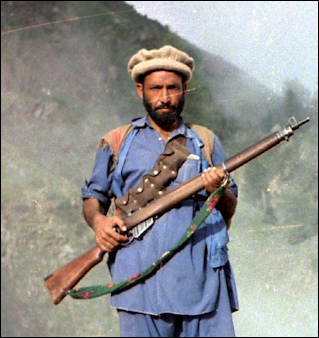
Mujahideen fighter with
with Enfield rifle in 1985 John-Thor Dahlburg and Alex Rodriguez wrote in the Los Angeles Times: “Bin Laden became a patron of the Afghan mujahedin, distributing money for shoes and weddings and visiting the wounded... When he arrived in Peshawar, Pakistan, the headquarters-in-exile of the Afghan resistance, he had a sizable purse to aid the cause. [Source: John-Thor Dahlburg and Alex Rodriguez, Los Angeles Times May 2, 2011]
Basil Muhammad, a Syrian journalist and author of The Arab Volunteers in Afghanistan, in which he wrote that bin Laden had first ventured into Afghanistan in 1984. Bin Laden told Muhammad: “I feel so guilty for listening to my friends and those that I love to not come here [to Afghanistan] and stay home for reasons of safety, and I feel that this delay of four years requires [my own] martyrdom in the name of God.” [Source: Peter Bergen, Vanity Fair, January 2006]
Jamal Ismail, who was an editor of Jihad magazine, said : “Coming to Peshawar on a visit in 1984, I met Mr. Osama bin Laden, one of the main financiers of the Services Office. I knew from the beginning that he was not willing to drink any soft drinks from American companies — Pepsi, Coca-Cola, Sprite, 7-Up. He is trying to boycott all American products because he believes that without the Americans Israel cannot exist.”
Jamal Khalifa, who joined his university friend bin Laden in Afghanistan: When we decided to work in Afghanistan, early “85, he told Bergenn: “What if you marry my sister Shaikha?” I told him, “Osama, we are going to war. We are going to die, and you’re asking me about marriage?” So he insisted and I told him, “O.K., look. If I came back and did not die, I will do it.” Despite the fact that he was married to bin Laden’s sister, Jamal Khalifa was angry about what he regarded as his friend’s foolhardy plan to set up his own military operation in Afghanistan.
“In 1986, bin Laden established a base next to a Soviet military post at Jaji, in eastern Afghanistan,” Bergen wrote. “Khalifa knew that bin Laden had no military experience, and he was concerned that young Arabs under bin Laden’s command were being sent on kamikaze missions against the Soviets. How much actual fighting he saw during the Soviet occupation is a matter of dispute, but his intense commitment was unquestioned.”
Khalifa said: “I decided to go myself [to Jaji] to see what’s going on there. I stayed three days. I started to ask the people how it’s going. They said every day, We have plenty of shaheeds [martyrs] — people dying. I said, “Why? They are not trained and they are very young. They don’t have experience and they are facing the Soviets. It’s not a joke.”
Khalifa said: I sat down with Osama in his tent underground. I told him, “Everybody is against this idea. Why are you here? Don’t you know that this is very dangerous?” He said, “We came to be in the front.” I said, “No, we did not come to be in the front. We came to [act as supporters of the] Afghans.” I told him, “Every drop of blood bleeds here in this place. God will ask you about it in the Hereafter. Everybody saying this is wrong, so Osama, please leave the place right now.” Everybody was hearing our argument; our voices become hard. I was really very angry; this is our first time to be like this. I told him, “Look, you will leave the place or I will never see you again.” He told me, “Do whatever you want.” So I left.

Mujahideen Afghanistan insurgency 1985
Abdullah Azzam
A key to Osama bin Laden’s transformation into a committed jihadist, Peter Bergen wrote in Vanity Fair “was his encounter with the charismatic Palestinian cleric Abdullah Azzam. Azzam was the critical force both ideologically and organizationally for the recruitment of Muslims from around the world to engage in the Afghan struggle against the Soviets.
Lawrence Wright wrote in The New Yorker: “In the mid-eighties, the dominant Arab in the war against the Soviets was Sheikh Abdullah Azzam, a Palestinian theologian who had a doctorate in Islamic law from Al-Azhar University. (He is not related to the Azzam family of Zawahiri's mother.) Azzam went on to teach at King Abdul Aziz University, in Jidda, where one of his students was Osama bin Laden. As soon as Azzam heard about the Soviet invasion of Afghanistan, he moved to Pakistan. He became the gatekeeper of jihad and its main fund-raiser. His formula for victory was "Jihad and the rifle alone: no negotiations, no conferences, and no dialogues." [Source: Lawrence Wright, The New Yorker, September 16, 2002]
Many of the qualities that people now attribute to bin Laden were seen earlier in Abdullah Azzam, who became his mentor. Azzam was the embodiment of the holy warrior, which, in the Muslim world, is as popular a heroic stereotype as the samurai in Japan or the Hollywood cowboy in America. His long beard was vividly black in the middle and white on either side, and whenever he talked about the war his gaze seemed to focus on some glorious interior vision. "I reached Afghanistan and could not believe my eyes," Azzam says in a recruitment video, produced in 1988, as he holds an AK-47 rifle in his lap. "I travelled to acquaint people with jihad for years. . . . We were trying to satisfy the thirst for martyrdom. We are still in love with this." Azzam was a frequent speaker at Muslim rallies, even in the United States, where he came to raise money, and he often appeared on Saudi television. Generous and elaborately polite, Azzam opened his home in Peshawar to many of the young men, mostly Arabs, who had heeded his fatwa for all Muslims to rally against the Soviet invader. When bin Laden first came to Peshawar, he stayed at Azzam's guesthouse. Together, they set up the Maktab al-Khadamat, or Services Bureau, to recruit and train resistance fighters.
Osama bin Laden and Abdullah Azzam
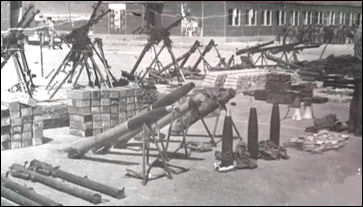
Mujahideen weaponry Azzam became bin Laden’s mentor, and in 1984 they founded the Services Office, an organization dedicated to placing Arab volunteers either with relief organizations serving the Afghan refugees who had flooded into Pakistan, or with the Afghan factions fighting the Soviets.”[Source: Peter Bergen, Vanity Fair, January 2006]
Hutaifa Azzam, the son of Abdullah Azzam, told Bergen: “Anyone who wanted to know anything about Afghanistan connects with my father. [He and Osama] met in the summer of 1984 in Jidda. Their relationship was very strong. I was very close to Osama. I still remember him driving a Land Cruiser, desert color; he took us to his farm, 40 kilometers from Jidda. We used to go there hunting. A vital project of Azzam and bin Laden’s Services Office was Jihad magazine, which the organization started up in the fall of 1984. A bimonthly, it was effectively the house organ of the Services Office, which would morph, in part, into al-Qaeda.” [Source: Peter Bergen, Vanity Fair, January 2006]
Abdullah Anas, one of the founders of the Services Office, told Begren: “The main aim of Azzam to build or to create the Jihad magazine is to inform the Arab world what is happening in Afghanistan; informing them, help funding, recruit people. [Eventually we printed] 70,000 copies an issue. And most of them go to the United States, because we had 52 centers in the United States. The main office was in Brooklyn, also Phoenix, Boston, Chicago, Tucson, Washington, D.C., Minnesota, and Washington State. Every year Azzam used to go to United States. The wealthy of United States can help much more than Muslims who are living in poor countries or under dictatorship.”
Azzam believed that jihad was the responsibility of all Muslims until the lands once held by Islam were reclaimed. John-Thor Dahlburg and Alex Rodriguez wrote in Los Angeles Times: For Azzam, reportedly one of the founders of the Palestinian militant group Hamas, there could be no compromise with the enemies of Islam: "Jihad and the rifle alone. No negotiations, no conferences and no dialogues." [Source: Kate Zernike and Michael T. Kaufman, New York Times, May 2, 2011; John-Thor Dahlburg and Alex Rodriguez, Los Angeles Times May 2, 2011]
Osama bin Laden Activities in Afghanistan
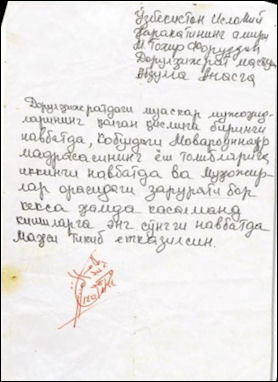
Mujahideen boot request In 1984, Osama bin Laden set up a guest house in Peshawar, Pakistan to channel Arab volunteers to the “mujahidin” and was the chief financier and logistic man for Maktab al-Khidamat (“The Office of Services”), an organization that recruited Arab volunteers for the fight against the Soviets. Later he set up camps and helped build cave hideouts in Afghanistan and founded an Arabic-language information service for the mujahidin. More Arab volunteers came. In 1989 the guesthouse and the organization were given a name — Al-Qaida (“The Base”).
Kate Zernike and Michael T. Kaufman wrote in the New York Times: Osama bin Laden “traveled more like a visiting diplomat than soldier, meeting with leaders and observing refugees coming into Peshawar, Pakistan. As the family friend said, it “was an exploratory rather than an action trip.” He returned twice a year for the next few years, in between finishing his degree and lobbying family members to support the Afghan mujahedeen. Bin Laden began traveling beyond the border into Afghanistan in 1982, bringing with him construction machinery and recruits. In 1984, he and Mr. Azzam began setting up guesthouses in Peshawar, which was the first stop for holy warriors on their way to Afghanistan. With the money they had raised in Saudi Arabia, they established the Office of Services, which branched out across the world to recruit young jihadists.” [Source: Kate Zernike and Michael T. Kaufman, New York Times, May 2, 2011]
“The recruits were known as the Afghan Arabs, though they came from all over the world, and their numbers were estimated as high as 20,000. By 1986, Bin Laden had begun setting up training camps for them as well, and he was paying roughly $25,000 a month to subsidize them. To young would-be recruits across the Arab world, Bin Laden’s was an attractive story: the rich young man who had become a warrior. His own descriptions of the battles he had seen, how he had lost the fear of death and slept in the face of artillery fire, were brushstrokes of an almost divine figure. Afghanistan also brought Bin Laden into contact with leaders of other militant Islamic groups, including Ayman al-Zawahri, the bespectacled doctor who would later appear at Bin Laden’s side in televised messages from the caves of Afghanistan. Ultimately Dr. Zawahri’s group, Egyptian Jihad, and others would merge with Al Qaeda, making it an umbrella for terrorist groups.”
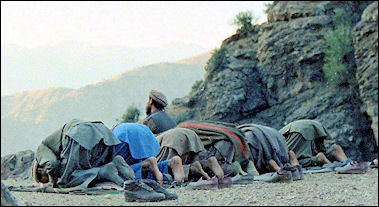
Mujahideen prayer John-Thor Dahlburg and Alex Rodriguez wrote in the Los Angeles Times: “In Afghanistan, Bin Laden's leadership skills and genius for organization became evident...With Azzam, Bin Laden founded the Mujahedin Services Bureau, an organization that sought to channel and strengthen the armed response of Muslims everywhere to the Afghans' plight. By the late 1980s, it reportedly had branches in 50 countries, including the United States.” [Source: John-Thor Dahlburg and Alex Rodriguez, Los Angeles Times May 2, 2011]
“Bin Laden launched a recruiting drive that enrolled thousands of volunteers. He set up half a dozen camps to train them in guerrilla warfare. Bin Laden also brought in bulldozers, dump trucks and other assets of his family's company, and drew on his background in construction to build trenches, roads and tunnels to aid the resistance. Many times, it is said, he dug emplacements on the front lines himself and kept working under enemy fire. He spent tens of millions of dollars of his fortune in Afghanistan, yet led the same spartan life as an ordinary fighter, sleeping on the floor of his Peshawar office on a pallet bed.”
“Word of the young Saudi's exploits spread through the Middle East, ensuring fresh fighters for the Afghan cause and a steady stream of contributions. According to one Western intelligence estimate, Bin Laden brought in about $50 million a year for the Afghan resistance. The United States was also generously bankrolling the anti-Soviet fighters. CIA agents from the period say they knew of Bin Laden and approved of what he was doing, but had no interaction with him.”
Osama bin Laden Breaks with Abdullah Azzam and Bonds with al-Zawahiri
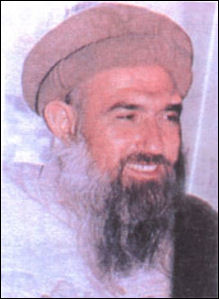
Abdullah Azzam Peter Bergen wrote in Vanity Fair: “Bin Laden’s military ambitions and personality evolved in tandem. He became more assertive, to the point that he ignored the advice of many old friends about the folly of setting up his own military force. That decision also precipitated an irrevocable (but carefully concealed) split with his onetime mentor, Abdullah Azzam. [Source: Peter Bergen, Vanity Fair, January 2006]
Hutaifa Azzam told Bergen: “You could say that bin Laden separated from my father in 1987. Bin Laden said that he wanted to make special camps for the Arabs only, where we can start our own jihad and we give the orders. We will gather all the Arabs in Afghanistan in one area in Jalalabad [in eastern Afghanistan]. My father was against that. He was shocked. So in 1987, Osama decided to separate and create special camps for the Arabs.”
Bergen wrote: “It was not an accident that bin Laden’s split from Abdullah Azzam began around the time of his first meeting with the Egyptian jihadist Dr. Ayman al-Zawahiri, in 1986. For bin Laden, the slightly older, cerebral Zawahiri (a surgeon by training) must have presented an intriguing figure. Zawahiri had first joined a jihadist group at 15 and had recently served three years in Egypt’s notorious prisons for his jihadist activities. For Zawahiri, bin Laden was on his way to becoming a genuine war hero, and his deep pockets were well known. In 1987, Zawahiri set up his own jihad group, which was soon supported by bin Laden.
Lawrence Wright wrote in The New Yorker: “Unlike the other leaders of the mujahideen, Zawahiri did not pledge himself to Sheikh Abdullah Azzam when he arrived in Afghanistan; from the start, he concentrated his efforts on getting close to bin Laden. He soon succeeded in placing trusted members of Islamic Jihad in key positions around bin Laden. According to the Islamist attorney Montasser al-Zayat, "Zawahiri completely controlled bin Laden. The largest share of bin Laden's financial support went to Zawahiri and the Jihad organization, while he supported the Islamic Group only with tiny morsels." [Source: Lawrence Wright, The New Yorker, September 16, 2002]
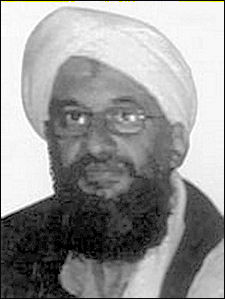
Zawahiri “Zawahiri must have recognized — perhaps even before bin Laden himself did — that the future of the Islamic movement lay with "this heaven-sent man," as Abdullah Azzam called bin Laden. Azzam soon felt the gravitational force of Zawahiri's influence over his protégé. "I don't know what some people are doing here in Peshawar," Azzam complained to his son-in-law Abdullah Anas. "They are talking against the mujahideen. They have only one point, to create fitna" — discord — "between me and these volunteers." He singled out Zawahiri as one of the troublemakers.
“Bin Laden's final break with Abdullah Azzam came in a dispute over the scope of jihad. Bin Laden envisioned an all-Arab legion, which eventually could be used to wage jihad in Saudi Arabia and Egypt. Sheikh Abdullah strongly opposed making war against fellow-Muslims. Zawahiri undermined Azzam's position by spreading rumors that he was a spy. "Zawahiri said he believed that Abdullah Azzam was working for the Americans," Osama Rushdi told me. "Sheikh Abdullah was killed that same night." On November 24, 1989, Azzam and two of his sons were blown up by a car bomb as they were driving to al-Falah Mosque in Peshawar. Although no one claimed credit for the killings, many have been blamed, including Zawahiri himself, and even bin Laden.” It was the second Azzam’s life in a month.. At Azzam's funeral, Zawahiri delivered a eulogy.
Osama bin Laden, a Mujahidin Fighter
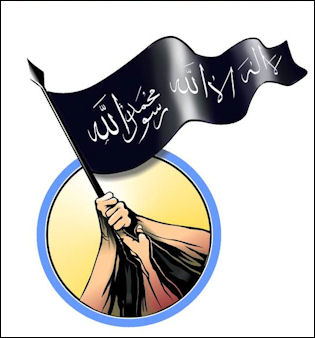
Mujahidin shura council Osama bin Laden organized and led a group of volunteers, mostly Arabs, with a few Afghans, in the eastern mountains of Afghanistan during the Soviet-Afghanistan war in the 1980s. He was respected by his family for his courage and devotion. In November 1989, Osama bin Laden became the head of the Arab fighters after Sheik Abdullah Azzam was killed. Most historians and experts regard him as a bit player who had little impact on the war.
Bin Laden described his fight in Afghanistan this way: “There I received volunteers who came from the Saudi kingdom and from all over the Arab and Muslim countries. I set up my first camp where these volunteers were trained by Pakistani and American officers. The weapons were supplied by the Americans, the money by the Saudis.” [Source: Kate Zernike and Michael T. Kaufman, New York Times, May 2, 2011]
Bin Laden was said to be very careful. He trusted no one and approached strangers or unknown packages with suspicion. Despite efforts by the Soviet to hunt him down and kill him he survived while many other fellow commanders died.
Describing Osama bin Laden in Afghanistan in 1989, French journalist Edward Girardet wrote in National Geographic, “A tall bearded man, flanked by armed men, stepped up to me demanding — in good English, with a slight American accent — what I, a “kafir” (infidel) was doing in Afghanistan. For the next 45 minutes we had a heated debate on the war, religion, and foreigners. Haughty, self-righteous and utterly sure of himself, he proceeded to lambaste the West for its feebleness and lack of moral conviction...When I announced that Western journalists and aid workers has been present in Afghanistan since the early days of the war, a time when no Arabs were not to be seen, he spat dismissively...Finally, he announced that if I returned, he would kill me.”
Action Seen by Osama bin Laden as a Mujahidin Fighter
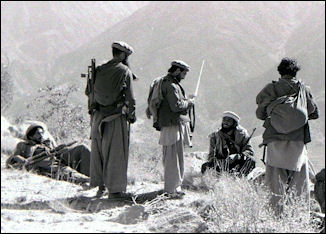
Mortar attack on Shigal Tarna
garrison, Kunar Province 87 Between 1984 and 1989, by some accounts, Osama bin Laden was in more in 40 bombing raids and fought in many battles, including the 1989 siege of Jalalabad, where he was wounded by shrapnel in an attack on the airport. He was wounded several times and hospitalized more than once. Osama bin Laden said that once a Soviet shell fell at his feet. In the seconds that transpired as he waited for it to explode he said he felt a sense of calmness. The shell never exploded. Some analysts believe a lot this is myth: that he saw little real fighting and was never wounded or injured.
John-Thor Dahlburg and Alex Rodriguez wrote in the Los Angeles Times: “In 1987, Bin Laden was commanding a group of mujahedin that attacked Soviet and pro-Moscow Afghan units in the eastern province of Paktia. The fighting degenerated into hand-to-hand combat, and the attackers had to withdraw. But Bin Laden seized what became a prop central to his public persona — the Kalashnikov automatic rifle that was usually by his side in television interviews or photographs. He claimed to have taken it from a dead Soviet general. [Source: John-Thor Dahlburg and Alex Rodriguez, Los Angeles Times May 2, 2011]
Khaled Batarfi, who remained in touch with bin Laden’s mother during the Soviet-Afghan war, told Peter Bergen that she became increasingly concerned about her son, especially after Osama supposedly suffered the effects of a Soviet gas attack: “The situation became worse when [Osama] went to jihad. In the beginning it wasn’t for jihad, it was going there just to support, so that was starting to worry his mother, and then he decided to become a fighter, and his mother — oh, God, it went from bad to worse. And then she heard about the chemical gas Russians used against mujahideen, and her son was affected. Since then, she was [watching] TV, waiting for bad news. [Source: Peter Bergen, Vanity Fair, January 2006]
Osama bin Laden at the Battle of Jaji Base
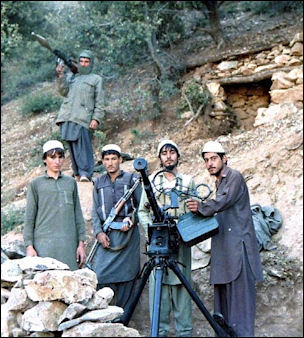
Jamiat e-Islami
in Shultan Valley 1987 with Dashaka Kate Zernike and Michael T. Kaufman wrote in the New York Times that bin Laden really “saw combat only once, in a weeklong barrage by the Soviets at Jaji, where the Arab Afghans had dug themselves into caves using Bin Laden’s construction equipment.” “Afghanistan, the jihad, was one terrific photo op for a lot of people,” Milton Bearden, the C.I.A. officer who described Bin Laden as “the North Star,” said in an interview on “Frontline,” adding, “There’s a lot of fiction in there.”
[Source: Kate Zernike and Michael T. Kaufman, New York Times, May 2, 2011]
“Still, Jaji became a kind of touchstone in the Bin Laden myth.” Zernike and Kaufman wrote “Stories sent back from the battle to Arab newspaper readers, and photographs of Bin Laden in combat gear, burnished his image. The flood of young men following him to Afghanistan prompted the founding of Al Qaeda. The genesis was essentially bureaucratic; Bin Laden wanted a way to track the men so he could tell their families what had happened to them. The documentation that Al Qaeda provided became a primitive database of young jihadists.
Peter Bergen wrote in Vanity Fair: “From his base in Jaji, bin Laden fought a key military engagement with the Soviets during the spring of 1987. This was a critical turning point in his life, when he left behind his role as a donor and fund-raiser for the mujahideen and launched his career as a holy warrior. Bin Laden, demonstrating the zeal of a fanatic, told the Syrian journalist Basil Muhammad that he hoped his new base would draw heavy Soviet fire: God willing, we want the Lion’s Den [in Jaji] to be the first thing that the enemy faces. Its place as the first camp visible to the enemy means that they will focus their bombardments on us in an extreme manner. [Source: Peter Bergen, Vanity Fair, January 2006]
Essam Deraz, an Egyptian writer and filmmaker who covered the battle of Jaji, told Bergen: “They picked the site at Jaji because it was on the front lines. In “87, it was a very important battle. The Arab group fought against Russian commandos. Not more than 50 or 60 young Arabs, 21, 22 [years old]. Most of them students at the universities. [Bin Laden] fought in this battle like a private. The Russian bombing went on for one week. It was clear now he’d be the leader. I was near him in the battle — many months — and he was really brave. That’s why he got respect from Afghans and Arabs.
Khalid Khawaja, a former Pakistani air-force officer who fought alongside bin Laden, told Bergen: “I participated in the Jaji battle. I was introduced to [bin Laden]. First of all he’s not a genius. He was 30 when I met him. He prayed a lot, always smiling. As a personality I never thought he would make a place in history — he is not charismatic. He is not very intelligent, but he is the most dedicated and self-sacrificing person, to a degree that is unparalleled.”
Osama bin Laden and His Links to the U.S. During the Mujahidin Years

Mujahideen with downed Soviet jet Milton Viorst wrote in the Washington Post: “By the mid-'80s, bin Laden was — supplying arms to the Afghan irregulars, the mujaheddin... Arms were now cheap. The United States was flooding the market, chiefly with Stingers, the anti-aircraft missiles that assured the Russians' defeat. [Source: Milton Viorst, Washington Post March 30, 2008;The Bin Ladens: An Arabian Family in the American Century by Steve Coll (Penguin Press, 2008)]
Despite reports to the contrary Osama bin Laden’s group never received any CIA funding and Osama bin Laden is believed to have had little or no contact with U.S. officials. He said in an interview in 1999, he “always hated the Americans because they are against Muslims...We didn’t want U.S. support in Afghanistan... we just happened to be fighting the same enemy.” Most of money for his activities is believed to have come from rich Saudis he knew.
Peter Bergen wrote in the Washington Post: During the Soviet war in Afghanistan during the 1980s, the CIA had no dealings with “Afghan Arabs” such as bin Laden and had few direct dealings with any of the Afghan mujaheddin. Instead, all U.S. aid to Afghanistan was funneled through Pakistan’s Inter-Services Intelligence agency, the ISI. Brigadier Mohammad Yousaf, the ISI officer who coordinated Pakistani efforts during the war, explained in “The Bear Trap,” his 1992 book: “No Americans ever trained or had direct contact with the mujaheddin.” [Source: Peter Bergen, Washington Post, May 6, 2011]
Since 9/11, al-Qaeda insiders have responded in writing to assertions that they had some kind of relationship with the CIA. Bin Laden’s top lieutenant, Ayman al-Zawahiri, in his autobiographical “Knights Under the Banner of the Prophet,” wrote, “The truth that everyone should learn is that the United States did not give one penny in aid to the [Arab] mujaheddin.” Similarly, Abu Musab al-Suri, long an associate of bin Laden’s, explained in his history of the jihadist movement, “The Call to Global Islamic Resistance”: “It is a big lie that the Afghan Arabs were formed with the backing of the CIA.” There are very few things that al-Qaeda and the CIA agree upon — except that they have never had any relationship.”
Mujahideen with shoulder-fired missile In research for his book “The Bin Ladens” Steve Coll found no record of CIA meetings with bin Laden. The agency knew who he was but showed no special interest in him or awareness of the danger his militancy represented. Kate Zernike and Michael T. Kaufman wrote in the New York Times: “The American did not deal directly with Bin Laden; they worked through the middlemen of the Pakistani intelligence service. In the revisionism of the Bin Laden myth, his defenders would say that he had not worked with the Americans but that he had only tolerated them as a means to his end. As proof, they insisted he had made anti-American statements as early as 1980. [Source: Kate Zernike and Michael T. Kaufman, New York Times, May 2, 2011]
Coll wrote in the "The Bin Ladens" that Osama bin Laden flew to London in 1986 to help negotiate the purchase of Russian-made surface-to-air missiles to be used by Arab fighters then battling the Soviet military in Afghanistan. Bin Laden and his half brother, Salem, met several times with the contacts at the luxury Dorchester hotel in London. "Don't do any jokes with my brother," Salem is said to have told the others. "He's very religious." [Source: Karen DeYoung, Washington Post, April 1, 2008]
Karen DeYoung wrote in the Washington Post: “The deal for Russian SA-7 missiles was arranged via "contacts" with the German arms manufacturer Heckler & Koch, through an associate of Salem bin Laden, the book says. It suggests that payment for the weapons was made by the government of Saudi Arabia and that the weapons eventually were purchased in South America.”
“At the time of the weapons shipments, both the U.S. and Saudi governments were supporting Afghan and Arab forces resisting the Soviet Union's occupation of Afghanistan. But while the Reagan administration supplied Stinger missiles to the Afghans, the book says that the Afghans did not want the Americans providing such weaponry directly to Arab groups that had joined the fight, including forces organized by Osama bin Laden.” "We have made no bones about our support for the mujaheddin" fighters, Saudi Embassy spokesman Nail al-Jubeir told the Washington Post. "We matched the Americans dollar for dollar." But "in terms of what was bought, I really don't know," he said, adding that the Arabs eventually did receive the SA-7s.”
“Among other revelations,” DeYoung wrote in the Washington Post, “the book says that Jalaluddin Haqqani, an Afghan fighter against the Soviets and now a Taliban leader in Pakistan, received tens of thousands of dollars from the CIA as a "unilateral" asset of the intelligence agency in 1988 and 1989. It also says that U.S. intelligence installed a listening device in a desk presented in the late 1970s to Saudi Prince Nayef when he became interior minister. Nayef's discovery of the bug, it says, negatively colored his views of the United States and inhibited his cooperation with U.S. counterterrorism efforts following the Sept. 11, 2001, attacks on the World Trade Center and the Pentagon.
Osama bin Laden on the Soviet-Afghanistan As a Prelude to a Large War with the West
Osama bin Laden viewed the war against the Soviets not as nationalist war for Afghan freedom but as a jihad against the West and wanted to expand the jihad to the Middle East. He helped set up charities that helped Afghan veterans and oppressed Muslims in places like Bosnia, Chechnya, Somalia and the Philippines and took some Afghan fighter to Yemen to fight against Communists there.”

U.S. President Ronald Reagan meets the Mujahideen at the White House
Bin Laden told a French journalist in 1995: “For us, the idea was not to get involved more than necessary in the fight against the Russians, which was the business of the Americans, but rather to show our solidarity with our Islamist brothers. I discovered that it was not enough to fight in Afghanistan, but that we had to fight on all fronts against Communism or Western oppression. The urgent thing was Communism, but the next target was America.” Bin Laden told an another interviewer: “Most of what we benefited from was that the myth of the superpower was destroyed not only in my mind but also in the minds of all Muslims,” “Slumber and fatigue vanished, and so was the terror which the U.S. would use in its media by attributing itself superpower status, or which the Soviet Union used by attributing itself as a superpower.”
John-Thor Dahlburg and Alex Rodriguez wrote in the Los Angeles Times: “In 1988, a number of the foreign fighters made a decision whose effects are still being felt today. The Soviets, it seemed clear, were on the run. The moment had come to turn the hammer of radical Islam against corrupt and pro-Western regimes in Egypt, Saudi Arabia and other countries. Among those involved was Omar Abdel Rahman, who would later be convicted of masterminding a plot to blow up New York City landmarks in the early 1990s. When the metamorphosis was complete, the organization created to fund and staff the anti-Soviet struggle had become Al Qaeda, a multinational network of Muslim extremists. [Source: John-Thor Dahlburg and Alex Rodriguez, Los Angeles Times May 2, 2011]
Image Sources: Wikimedia Commons except first picture from Time magazine and Zawahiri, the FBI
Text Sources: New York Times, Washington Post, Los Angeles Times, Times of London, The Guardian, National Geographic, The New Yorker, Time, Newsweek, Reuters, AP, AFP, Wall Street Journal, The Atlantic Monthly, The Economist, Global Viewpoint (Christian Science Monitor), Foreign Policy, Wikipedia, BBC, CNN, NBC News, Fox News and various books and other publications.
Last updated July 2012


